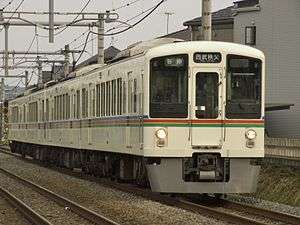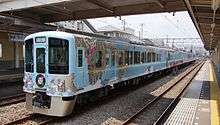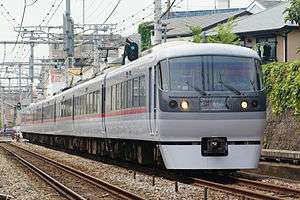Seibu 4000 series
The Seibu 4000 series (西武4000系) is an electric multiple unit (EMU) train type operated by the private railway operator Seibu Railway mainly on Seibu Chichibu Line services in Saitama Prefecture, Japan since 1988.[1]
| Seibu 4000 series | |
|---|---|
 A 4000 series set on the Seibu Chichibu Line in August 2009 | |
| In service | 1988 - Present |
| Manufacturer | Tokyu Car Corporation |
| Constructed | 1988-1992 |
| Refurbished | 2002 |
| Number built | 48 vehicles (12 sets) |
| Number in service | 48 vehicles (12 sets) |
| Formation | 4 cars per trainset |
| Fleet numbers | 4001-4023 |
| Operator(s) | Seibu Railway |
| Depot(s) | Musashigaoka |
| Line(s) served | Seibu Ikebukuro Line, Seibu Chichibu Line, Chichibu Main Line |
| Specifications | |
| Car body construction | Steel |
| Car length | 20 m (65 ft 7 in) |
| Doors | 2 pairs per side |
| Maximum speed | 105 km/h (65 mph) |
| Power output | 150 kW |
| Acceleration | 2.3 km/h/s |
| Electric system(s) | 1,500 V DC |
| Current collection method | overhead catenary |
| Track gauge | 1,067 mm (3 ft 6 in) |
Design
The 4000 series trains were built between 1988 and 1992 by combining electrical equipment from former 101 series EMUs with new steel bodies.[1] The trains are finished in a livery of ivory white with blue, red, and green stripes along the waist line, the team colours of the Saitama Seibu Lions baseball team.[1] The driving cabs have a similar configuration to the earlier 101 series and 2000 series EMUs, with a left-hand master controller and right-hand brake control.[1]
 The driving cab console
The driving cab console
Operations
The fleet of four-car trains is primarily used on all-stations driver only operation "Local" services on the Seibu Chichibu Line between Hannō and Seibu Chichibu, but the trains are also used as eight-car formations on through "Rapid Express" train services from Ikebukuro on the Seibu Ikebukuro Line to Mitsumineguchi and Nagatoro on the Chichibu Main Line.[1] These trains divide and couple at Yokoze, with separate portions for Mitsumineguchi and Nagatoro.[1]
Fleet
As of 1 April 2016, the fleet consists of twelve four-car sets, numbered 4001 to 4023, based at Musashigaoka depot.[2]
Formations
Sets are formed as shown below with two motored ("M") cars and two non-powered driving trailer ("Tc") cars, and the Tc1 car at the southern (Ikebukuro) end.[2]
| Designation | Tc1 | M1 | M2 | Tc2 |
|---|---|---|---|---|
| Numbering | 40xx | 41xx | 41xx | 40xx |
The M1 car is fitted with two single-arm pantographs (originally lozenge-type pantographs).[1][2]
- Car 4002 of set 4001 in May 2006
- Car 4001 of set 4001 in May 2006
Interior
Seating mainly consists of fixed 4-person facing seating bays, with longitudinal bench seating next to the doorways.[1] The Tc1 car has a toilet.[2]
 Train interior view
Train interior view 4-person seating bay
4-person seating bay Toilet and priority seating
Toilet and priority seating Wheelchair space
Wheelchair space
History
The first train entered service in 1988, with twelve four-car sets built by 1992.[1] The fleet was refurbished in 2002 for use on wanman driver only operation services on the Seibu Chichibu Line. Modifications included the addition of automatic passenger announcements.[1]
Fifty-two Seats of Happiness

One four-car set was modified from set 4009 into a tourist train called the Fifty-two Seats of Happiness (52席の至福, Gojūni seki no shifuku) for use on services operating between Seibu Shinjuku and Ikebukuro in Tokyo and Seibu Chichibu and Hon-Kawagoe in Saitama Prefecture, entering service from 17 April 2016.[4] The interior and exterior design of the train was overseen by architect Kengo Kuma.[5]
The automated on-board passenger announcements in Japanese use the voice of TV presenter Tomomi Kuno, and the melody chimes accompanying the announcements were created by musician Minoru Mukaiya, who was formerly the keyboard player in the group Casiopea.
The train is formed as shown below, with car 1 at the Tokyo (southern) end.[2][6]
| Car No. | 1 | 2 | 3 | 4 |
|---|---|---|---|---|
| Numbering | 4009 | 4109 | 4110 | 4010 |
| Seating capacity | - | 26 | - | 26 |
| Facilities | Multipurpose space, toilets | Dining seating | Open kitchen | Dining seating |
 Car 4009 (car 1) with spring motif
Car 4009 (car 1) with spring motif Car 4109 (car 2) with summer motif
Car 4109 (car 2) with summer motif Car 4110 (car 3) with autumn motif
Car 4110 (car 3) with autumn motif Car 4010 (car 4) with winter motif
Car 4010 (car 4) with winter motif
Special liveries
From 16 January 2016, set 4015 received a special Hello Kitty livery as part of a campaign to promote tourism to the Chichibu area. It is scheduled to operate in this livery until 27 March 2016.[7]
References
- 私鉄車両年鑑 2013: 大手15社営業用車両完全網羅 私鉄車両年鑑2013 [Japan Private Railways Annual 2013]. Tokyo, Japan: Ikaros Publications Ltd. 20 March 2013. p. 201. ISBN 978-4-86320-693-9.
- 私鉄車両編成表 2016 [Private Railway Rolling Stock Formations - 2016] (in Japanese). Japan: Kotsu Shimbunsha. 25 July 2016. p. 48. ISBN 978-4-330-70116-5.
- “西武 旅するレストラン「52席の至福」”が営業運転を開始 [Seibu "52 Seats of Happiness" travelling restaurant enters service]. Japan Railfan Magazine Online (in Japanese). Japan: Koyusha Co., Ltd. 18 April 2016. Retrieved 18 April 2016.
- Osumi, Magdalena (28 December 2015). "Seibu to debut dinner trains featuring local fare on its scenic Chichibu Line from spring". The Japan Times. Japan: The Japan Times Ltd. Retrieved 30 December 2015.
- 西武鉄道 2016年春「秩父」をモチーフとした観光電車デビュー [Seibu Railway to launch Chichibu-themed tourist train in spring 2016]. Tetsudo Hobidas (in Japanese). Japan: Neko Publishing Co., Ltd. 16 June 2015. Retrieved 16 June 2015.
- 西武鉄道で「秩父 ハローキティ トレイン」運転 [Seibu Railway operates "Chichibu Hello Kitty Train"]. Japan Railfan Magazine Online (in Japanese). Japan: Koyusha Co., Ltd. 17 January 2016. Retrieved 17 January 2016.
External links
| Wikimedia Commons has media related to Seibu 4000 series. |
- Seibu 4000 series train information (in Japanese)
- Fifty-two Seats of Happiness train information (in Japanese)
